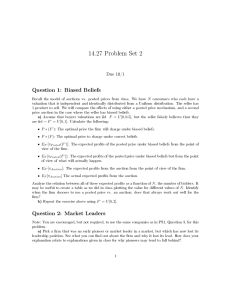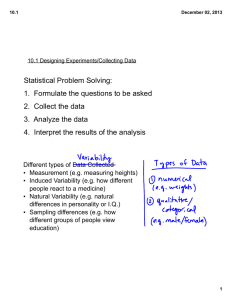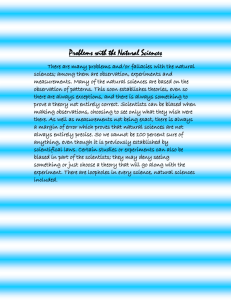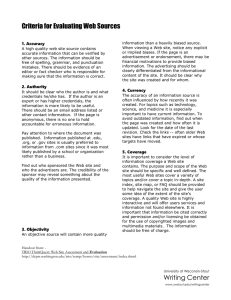14.27 Problem Set 2 Question 1: Biased Beliefs Due 10/1
advertisement
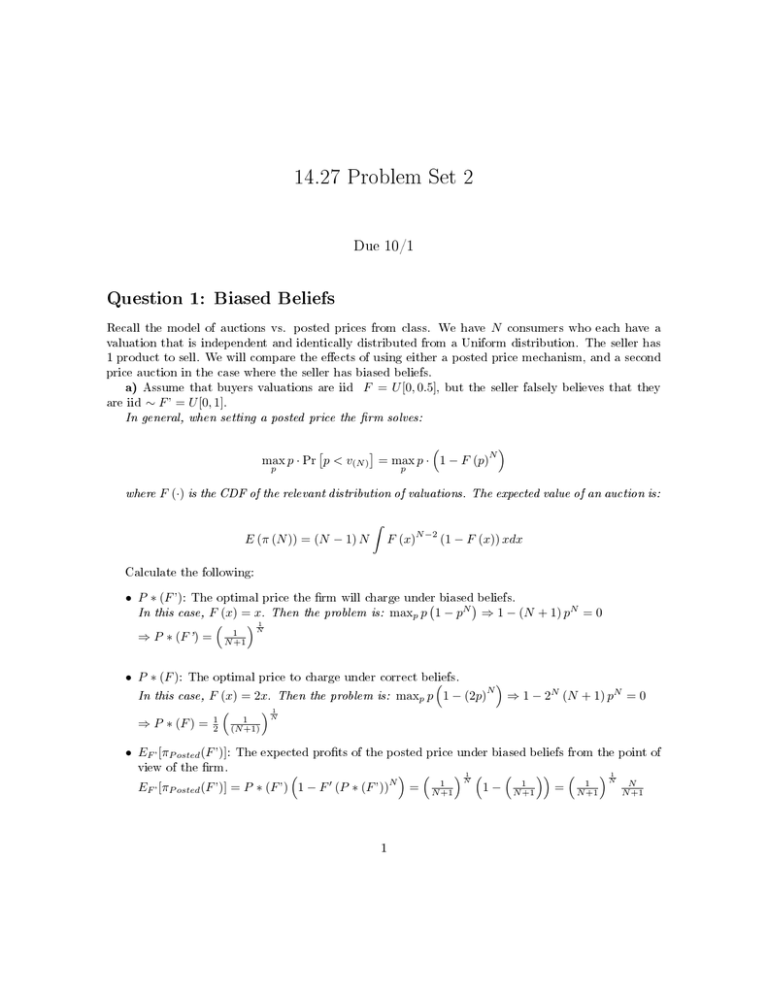
14.27 Problem Set 2 Due 10/1 Question 1: Biased Beliefs Recall the model of auctions vs. posted prices from class. We have N consumers who each have a valuation that is independent and identically distributed from a Uniform distribution. The seller has 1 product to sell. We will compare the eects of using either a posted price mechanism, and a second price auction in the case where the seller has biased beliefs. a) Assume that buyers valuations are iid F = U [0, 0.5], but the seller falsely believes that they are iid ∼ F ' = U [0, 1]. In general, when setting a posted price the rm solves: N max p · Pr p < v(N ) = max p · 1 − F (p) p p where F (·) is the CDF of the relevant distribution of valuations. The expected value of an auction is: ˆ E (π (N )) = (N − 1) N N −2 F (x) (1 − F (x)) xdx Calculate the following: • P ∗ (F '): The optimal price the rm will charge under biasedbeliefs. In this case, F (x) = x. Then the problem is: maxp p 1 − pN ⇒ 1 − (N + 1) pN = 0 N1 ⇒ P ∗ (F ') = N1+1 • P ∗ (F ): The optimal price to charge under correct beliefs. In this case, F (x) = 2x. Then the problem is: maxp p 1 − (2p)N ⇒ 1 − 2N (N + 1) pN = 0 N1 ⇒ P ∗ (F ) = 12 (N1+1) • EF ' [πP osted (F ')]: The expected prots of the posted price under biased beliefs from the point of view of the rm. N1 N1 N 1 − N1+1 = N1+1 EF [πP osted (F ')] = P ∗ (F ') 1 − F 0 (P ∗ (F ')) = N1+1 ' 1 N N +1 N Biased Price Optimal Price 2 3 4 5 6 7 8 9 10 11 12 13 14 15 16 17 18 19 20 0.69 0.71 0.72 0.74 0.76 0.77 0.78 0.79 0.80 0.81 0.82 0.83 0.83 0.84 0.85 0.85 0.86 0.86 0.87 0.35 0.35 0.36 0.37 0.38 0.39 0.39 0.40 0.40 0.41 0.41 0.41 0.42 0.42 0.42 0.43 0.43 0.43 0.43 Posted Price Auction Expected True Profits, Expected Expected True Profits, Profits, Optimal Profits, Biased Profits, Correct Biased Price Biased Price Price Beliefs Beliefs 0.46 0 0.17 0.33 0.17 0.53 0 0.18 0.50 0.25 0.58 0 0.18 0.60 0.30 0.62 0 0.19 0.67 0.33 0.65 0 0.19 0.71 0.36 0.67 0 0.19 0.75 0.38 0.70 0 0.20 0.78 0.39 0.71 0 0.20 0.80 0.40 0.73 0 0.20 0.82 0.41 0.75 0 0.20 0.83 0.42 0.76 0 0.21 0.85 0.42 0.77 0 0.21 0.86 0.43 0.78 0 0.21 0.87 0.43 0.79 0 0.21 0.88 0.44 0.80 0 0.21 0.88 0.44 0.80 0 0.21 0.89 0.44 0.81 0 0.21 0.89 0.45 0.82 0 0.22 0.90 0.45 0.82 0 0.22 0.90 0.45 Figure 1: Prot Comparison • EF [πP osted (F ')]: The expected prots of the posted price under biased beliefs but from the point of view of what will actually happen. N N EF [πP osted (F ')] = P ∗ (F 0 ) 1 − F (P ∗ (F ')) = P ∗ (F 0 ) max 1 − (2P ∗ (F 0 )) , 0 = 1 (N +1) N1 max 1 − 2N (N +1) , 0 • EF 0 [πAuction ]: The expected rm. ´ prots from the auction from the ´ point of view of the −1 EF 0 [πAuction ] = (N − 1) N xN −2 (1 − x) xdx = (N − 1) N xN −1 − xN dx = N N +1 • EF [πAuction ] The actual expected prots from the auction. In this case, f (x) = 2 and ´F (x) = 2x. Then: ´ 0.5 N −1 N −2 EF 0 [πAuction ] = (N − 1) N 2 (2x) (1 − 2x) xdx = 2N −1 (N − 1) N 0 x − 2xN dx h N i N +1 0.5 −1 = 2N −1 (N − 1) N xN − 2 xN +1 = 12 N N +1 0 Analyze the relation between all of these expected prots as a function of N , the number of bidders. It may be useful to create a table as we did in class plotting the value for dierent values of N . Identify when the rm chooses to use a posted price vs. an auction: does that always work out well for the rm? Note that the true prots under the biased optimal price are always 0! This is in contrast to the 2 auction, where under true and biased beliefs prots are always positive. The rm chooses an auction for N ≥ 4, and really should pick an auction for N ≥ 3. b) Repeat the exercise above using F ' = U [0, 2]. • P ∗ (F '): The optimal price the rm will charge under biased beliefs. N In this case, F (x) = 21 x. Then the problem is: maxp p 1 − p2 ⇒1− N1 ⇒ P ∗ (F ') = 2 N1+1 (N +1) N p 2N =0 • EF ' [πP osted (F ')]: The expected prots of the posted price under biased beliefs from the point of view of the rm. N1 N N EF [πP osted (F ')] = P ∗ (F ') 1 − F 0 (P ∗ (F ')) = 2 N1+1 N +1 ' • EF [πP osted (F ')]: The expected prots of the posted price under biased beliefs but from the point of view of what will actually happen. N1 N EF [πP osted (F ')] = P ∗ (F 0 ) 1 − F (P ∗ (F ')) = 2 (N1+1) max 1 − 4N N1+1 , 0 • EF 0 [πAuction ]: The expected prots from the auction from the point of view of the rm. N −1 ´ 2 N −1 xN ´2 x − 2 dx EF 0 [πAuction ] = (N − 1) N 0 x2 N −2 1 − x2 x 12 dx = (N − 1) N 12 0 N −1 = 2 N +1 • EF [πAuction ] The actual expected prots from the auction. These do not change: 1 N −1 2 N +1 3 N Biased Price Optimal Price 2 3 4 5 6 7 8 9 10 11 12 13 14 15 16 17 18 19 20 1.39 1.41 1.45 1.48 1.51 1.54 1.57 1.59 1.61 1.63 1.64 1.66 1.67 1.68 1.69 1.70 1.71 1.72 1.73 0.69 0.71 0.72 0.74 0.76 0.77 0.78 0.79 0.80 0.81 0.82 0.83 0.83 0.84 0.85 0.85 0.86 0.86 0.87 Posted Price Auction Expected True Profits, Expected Expected True Profits, Profits, Optimal Profits, Biased Profits, Correct Biased Price Biased Price Price Beliefs Beliefs 0.92 0 0.35 0.67 0.33 1.06 0 0.35 1.00 0.50 1.16 0 0.36 1.20 0.60 1.24 0 0.37 1.33 0.67 1.30 0 0.38 1.43 0.71 1.35 0 0.39 1.50 0.75 1.39 0 0.39 1.56 0.78 1.43 0 0.40 1.60 0.80 1.46 0 0.40 1.64 0.82 1.49 0 0.41 1.67 0.83 1.52 0 0.41 1.69 0.85 1.54 0 0.41 1.71 0.86 1.56 0 0.42 1.73 0.87 1.58 0 0.42 1.75 0.88 1.59 0 0.42 1.76 0.88 1.61 0 0.43 1.78 0.89 1.62 0 0.43 1.79 0.89 1.64 0 0.43 1.80 0.90 1.65 0 0.43 1.81 0.90 Figure 2: Prot Comparison 4 MIT OpenCourseWare http://ocw.mit.edu 14.27 Economics and E-Commerce Fall 2014 For information about citing these materials or our Terms of Use, visit: http://ocw.mit.edu/terms.
